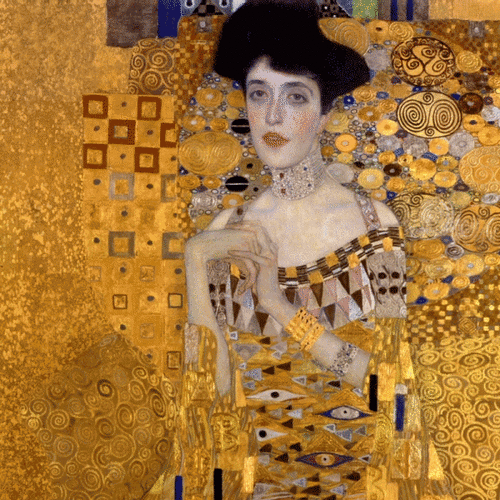
Gustav Klimt and his Viennese beauties come to us via the Legion of Honor in celebration of the centenary of Rodin and Klimt's deaths.
Each day hundreds—nay—thousands of individuals shuffle through the doors of the Legion of Honor for the chance to stand elbow-to-elbow with complete strangers while contemplating art, battling museum fatigue, getting reprimanded by museum guards, and wondering what why the heck Rococo was a thing. If you’re lucky, you may even get a few perfectly placed instagram pics along the way (as long as you're aware of your surroundings). Just look at what I snapped while casually meandering to the car.
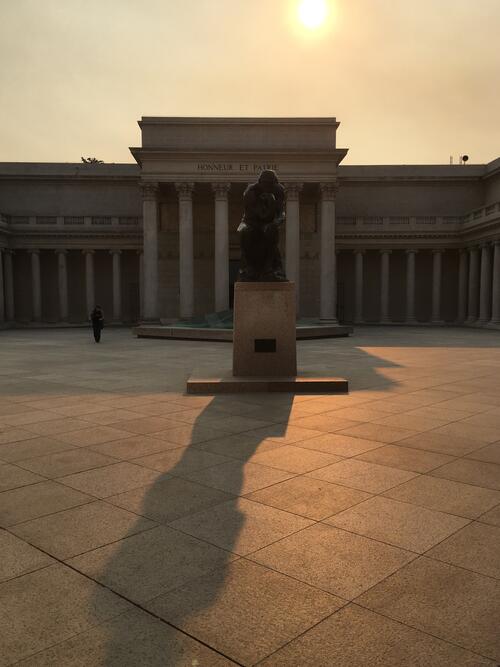
The museum is used to all this. It’s us who should be preparing because it's about to get so. much. busier. on that hill with the arrival of their latest boon to two masters, Klimt and Rodin: An Artistic Encounter. Like Urs Fisher and Sarah Lucas before him, Klimt’s work is thoughtfully placed within Rodin’s to dialogue with and draw new meaning from his sculptures.

How's this for a tragic love story? Although they only met on one occasion, Gustav Klimt and Auguste Rodin were soul mates for their whole lives. They even died within four months of each other, and if that’s not destiny I don’t know what is. Now, almost a hundred years after their respective deaths, Gustav Klimt is finally taking his very first trip to California to visit his longtime artistic equal (and unrequited BFF?). When the two masters are viewed side-by-side, the parallels are undeniable: aside from obvious similarities in technique and subject matter, they were both highly criticized for breaking artistic boundaries. Rodin pioneered an artistic language that proved highly influential to this particular group of Viennese visionaries.

Many of the Klimt pieces on display are having their grand debut in the U.S., and all of them are on the West Coast for the first time, making this the first major exhibition of Klimt’s work in America. Despite a serious lack of gold, this exhibition left us in a state of Klimt-induced euphoria for the rest of the evening—it's definitely not to be missed. And as always, we’re here to pique your interest with a sneak preview of some heavy-hitters.
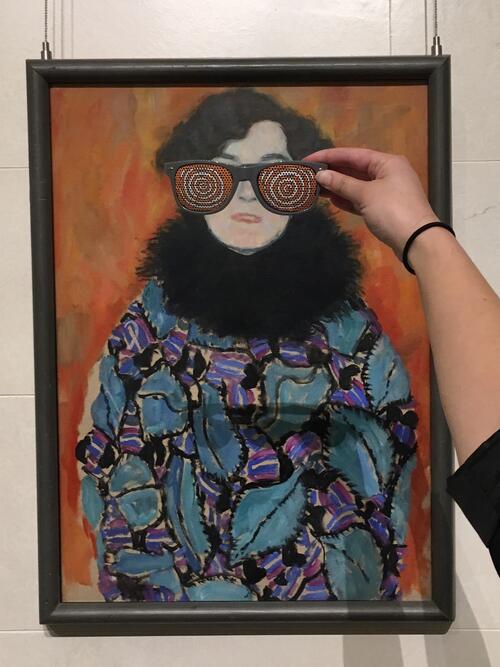
Portrait of Johanna Staude by Gustav Klimt in the Austrian Gallery at Belvedere
But first, we couldn’t resist handing out some Sartle swag. The glasses go with her ensemble, no?
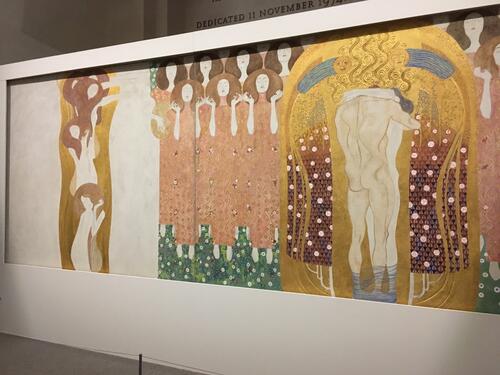
Replica of panel 10 ( the Arts) from the Beethoven Frieze (left) and Replica of panel 11 (Paradise Choir and Embrace) from the Beethoven Frieze (right) by Gustav Klimt at the Austrian Gallery at Belvedere
The tone for the entire exhibition is set by these replicas of Klimt's Beethoven Frieze—a work that can, under no circumstances, leave its hometown. In fact, today it remains in the very same building that hosted it during the infamous 1902 exhibition of artists belonging to the so-called Vienna Secession movement. Of course, Klimt and his rebellious gang recieved this title because they were literally seceding, or removing themselves, from the artistic movements of the past to usher in a flourishing new age of Modernism in Austria.
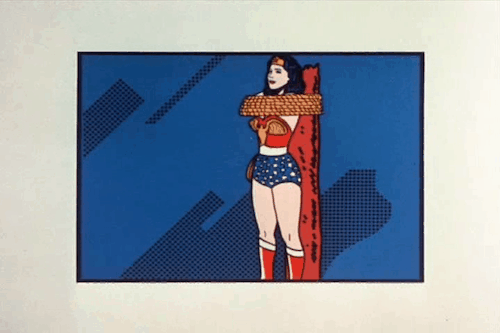
The exhibition was a collective homage to the composer, Ludwig van Beethoven, and featured work from twenty-one different artists. Klimt's contribution was this 112-foot-long frieze that lined the walls of the entire building, a visual representation of Beethoven's Ninth Symphony. They had every intention of destroying the work immediately after the closing of the show that spanned just two months, until the Secession fortuitously decided to leave the work intact, as they would be displaying a major Klimt retrospective the following year. I hope whoever made that decision got a raise, as it's the only reason that we can still view the work today.

It was subsequently purchased by Carl Reinighaus, a major art collector and patron, cut into seven pieces in order to be removed from the wall, and stored in a furniture depot in Vienna for the next twelve years. He eventually sold the whole lot, at which point it was obtained by a Jewish collector who held onto it for a while before Austria could purchase it back. Whether it was given up willingly or forcibly purchased is questionable, but that's another blog for another day. The piece received some well-deserved R&R (rest and restoration) for the next ten years while a room was prepared in the basement of the newly renovated Secession building to welcome it home.
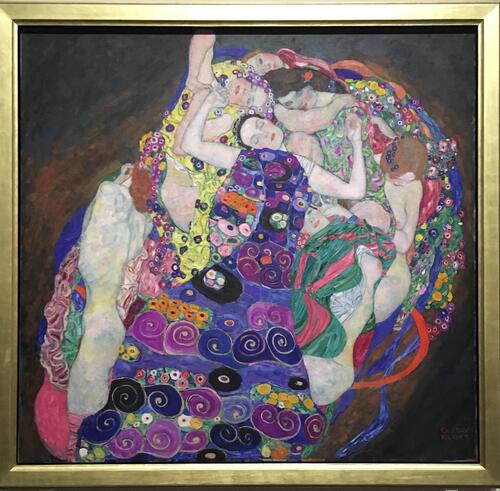
The Virgin by Gustav Klimt at the National Gallery in Prague
Before unleashing us into the exhibition, Dr. Tobias G. Natter, the guest curator of the exhibition, specified the three themes that persist throughout these thirty-six works by Gustav Klimt: color, ornament, and eroticism. The Virgin presents us with all this and even a little somethin' extra.
As the title explicitly states, the woman in the middle is his representation of a virgin. Honestly though, if I didn't know the title, I would probably think that she was giving birth because of the gloriously vibrant colors and decoration pouring out from her spread-eagle legs. Although it's admittedly quite difficult to tell which limbs belong to which body in this angelic cuddle sesh, Klimt's pleasing composition draws us into this entanglement that likely represents the transition from adolescence to womanhood (cue B. Spears).
Like many others, this piece rarely leaves Viennese borders—it's journey to San Francisco is the first time it has traveled in over twenty years.
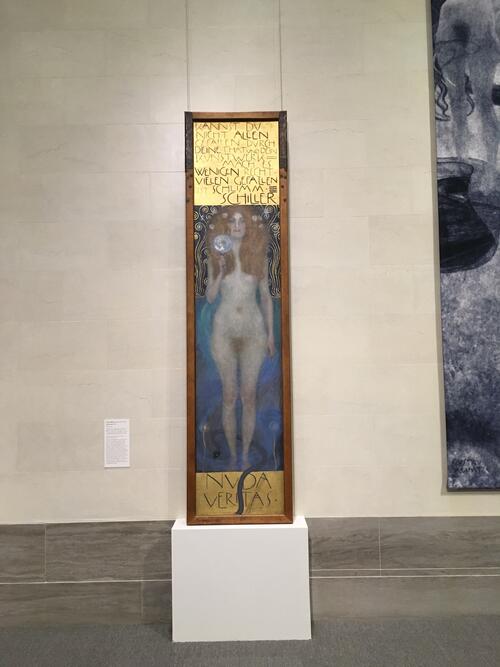
Nuda Veritas by Gustav Klimt at the Austrian Theatre Museum
Nuda Veritas was basically Klimt's response to the haters; an early 20th century version of Taylor Swift's Look What You Made Me Do, only much less contrived. The text at the top of the panel reads, "If you cannot please everyone with your actions and your art, you should satisfy a few. To please many is dangerous." At the bottom, "Nuda Veritas" (nakedness is truth) is scrawled in large letters. It was intended to be huge middle finger to everyone who told him that his work—for both the nude bodies and avant garde style—was too risqué, or that he should disguise his nude figures with allegory and symbolism. It is, in effect, his manifesto.

Nuda Veritas by Gustav Klimt at the Austrian Theatre Museum (left) with The Age of Bronze by Auguste Rodin at the Legion of Honor (right)
Rodin's Age of Bronze was also highly controversial at its inception, causing a similar scandal for exactly the same reason. Both are completely rooted in the here and now, devoid of any attempt to disguise the naked body.
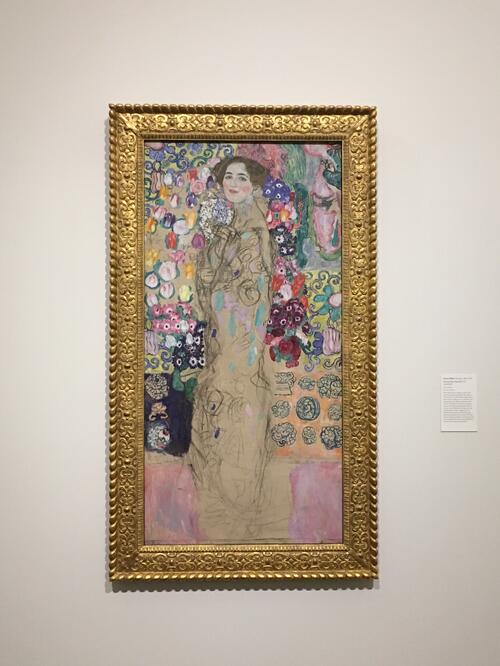
Portrait of Ria Munk III by Gustav Klimt in The Lewis Collection
After 1900, Klimt began painting and drawing exclusively women. He was always fascinated with the female form, but at a certain point he began obsessing over it. This particular female portrait represents Ria Munk, the niece of one of Klimt's most important patrons, Szerena Lederer. Munk committed suicide at the age of twenty-four, which makes it likely that Lederer had this portrait commissioned posthumously. This could explain why he found it difficult to finish this piece, as is apparent by the amount of it left untouched. Although an uncommon occurrence, unfinished work offers us a glimpse into Klimt's mind and artistic process.

After Rodin saw the 1902 Beethoven Exhibition, he sat down to a meal with Klimt and remarked, "I've never before experienced such an atmosphere—your tragic and magnificent Beethoven Fresco...What is the reason for it all?" Klimt slowly nodded his head and responded with one word, "Austria."
Klimt and Rodin: An Artistic Encounter will be on view through January 28, 2018. Unless you plan on making a trip to Austria, this may be your first and last opportunity to see this much Klimt all in one place. So, what are you waiting for?
If you're interested in learning more about the exhibition and its content, you can check out the Legion's digital story, which presents a stylish and informative overview of all the artwork.
Until next time!

By Rose Cannon











